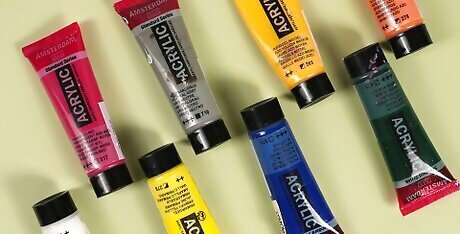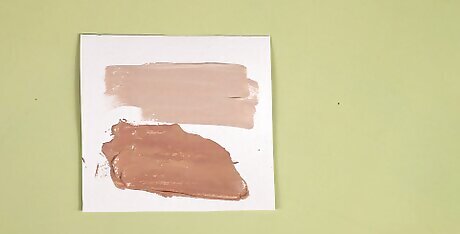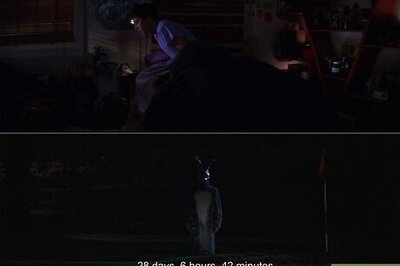
views
Mixing Paints to Make Tan

Use an amount of white paint equal to how much tan paint you need. Since white paint is the base of and largest component in tan paint, you should add as much white paint as you need tan paint. Add the white paint to your mixing container or pallet. It’s best to start with as much paint as you think you’ll need at the outset rather than to continue adding white paint in future steps. You may struggle to eyeball the right shade and get off track with your tan color. When you’ve added all your white to your palette, rinse the white paint off your paintbrush. Dry the brush in a rag or cloth and dip it into brown paint.

Add a tiny dollop of brown paint to the white. Mix the two paint colors together until they’re completely combined. Repeat this process until you reach your desired shade of tan. Use only a tiny amount of brown each time you add more. Just a little too much brown paint can overwhelm the white paint and ruin the shade. At this point, you have made a basic tan paint color. If you want to make a more dynamic tan shade or skin color, proceed to the next step. If you want a darker shade of tan, add small amounts of brown or black paint to your mixture until you’re satisfied with the color.

Add a fingertip’s worth of red or yellow paint to create a tan skin color. Mix a small dollop of red or yellow paint into your white and brown mixture. Continue adding small amounts of the yellow and/or red paints until you’ve reached your desired tan skin shade. Adding too much at once may overpower the tan color and make it look too pinky or orangey. Choose a burnt sienna or reddish paint to create tan skin with pink undertones. Choose yellow ochre paint for a tan skin shade with yellowish undertones. For a neutral tan that’s still warm and dynamic, add equal parts of yellow and red paint. If you’d like to create a darker tan skin color, add small amounts of brown or black paint until you reach your desired shade.

Add red, yellow, or blue paints to create earth-toned tan shades. To create a warm, earthy tan, add a small brush’s worth of cadmium red and yellow acrylic paints until you find the right shade match. To create a paler, cool-toned tan shade, mix a deep blue acrylic shade into your brown-and-white paint mixture. To darken or lighten your tan shade at any point in the mixing process, add a small amount of black or dark brown paint. These shades will come in handy if you’re painting a landscape or nature scene. For instance, you may use a blueish tan to match the pale sand on a beach or a reddish tan to match desert clay.

Mix the paint thoroughly with a palette knife. Before applying your paint to a portrait or other art piece, make sure all colors are well distributed. Use your palette knife to scoop and turn over the paint repeatedly until it’s well-mixed. If you have any remaining pockets of brown, white, yellow, or red paint, they will make your finished color look patchy and uneven.
Mixing Acrylic vs. Watercolor vs. Oil Paints

Acrylic paints Using acrylic paints is great because they can be mixed very easily to make brown paint. Different shades of acrylic paints can be combined to create many different shades and hues. However, acrylic paints are known to dry very quickly. You’ll have to work fast when mixing colors so that your tan shade is still usable by the time you start painting. Extend the working time of acrylic paints by blending in an acrylic medium or acrylic retarder.

Watercolor paints Watercolor paints are generally easier to blend and mix than acrylics. When you make tan paint with watercolors, you’re able to dilute the paints with water to create different levels of transparency in the shade. Plus, you can reactivate watercolor paints after they dry to use your tan shade again and again! However, watercolor paint may be more difficult for beginners as your tan color can turn muddy if you don’t use the proper mixing technique for watercolors. Avoid letting dry areas of paint come into contact with newly wet areas or using too many sedimentary colors together.

Oil paints Oil paints are considered more difficult to mix than watercolors and acrylics due to long drying times and unique consistencies. Most painters add a medium to make the oil paint easier to work with or a solvent, like turpentine, to make it dry faster. Oil paints also require a lot of mixing to perfect the color, but their precision allows artists to find the exact shade that they want. Keep in mind that the linseed oil typically used in or mixed with oil paints may give a yellowish tint to your tan paint.
What color is tan?

Tan is a warm, light shade of brown. More complex tan shades often have a touch of yellow or red, giving them an orangey-brown hue. Tan is considered a medium-toned neutral color. In painting, tan paint shades are often used to paint portraits of people with tanned skin. As a color, tan symbolizes growth, warmth, security, and healing. Its rustic, earthy color evokes a sense of peace, comfort, and natural beauty. In graphic design, a standard tan shade has the hex code #D2B48C. There are many shades of lighter and darker tan hues, including desert tan (#C49E78) and Windsor tan (#A75502).

Beige and tan are two distinct shades of brown. These colors are often confused because they’re both neutral, muted colors with brown undertones. However, tan is a browner shade with warm, orange undertones. Beige is a lighter, more neutral shade of brown with yellow and gray undertones.

















Comments
0 comment